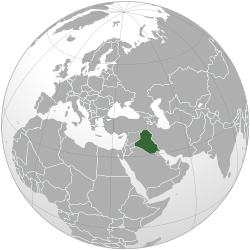Baathist Iraq
| Iraqi Republic | ||||||||||
|
الجمهورية العراقية al-Jumhūrīyah al-‘Irāqīyah |
||||||||||
|
||||||||||
|
||||||||||
|
Motto (Arabic: "وحدة، حرية، اشتراكية") "Wahda, Hurriyah, Ishtirakiyah" (1986–1991) (English: "Unity, Freedom, Socialism") "Allāhu Akbar" (1991–2003) |
||||||||||
|
Anthem "Ardulfurataini Watan" (1981–2003) (English: "The Land of the Two Rivers") |
||||||||||
| Capital | Baghdad | |||||||||
| Languages | Arabic · Kurdish | |||||||||
| Religion |
Islam · Christianity Judaism · Yazidism Mandaeism |
|||||||||
| Government | Unitary Ba'athist one-party socialist state | |||||||||
| President | ||||||||||
| • | 1968–1979 | Hassan al-Bakr (first) | ||||||||
| • | 1979–2003 | Saddam Hussein (last) | ||||||||
| Prime Minister | ||||||||||
| • | 1968 | Abd an-Naif (first) | ||||||||
| • | 1994–2003 | Saddam Hussein (last) | ||||||||
| Legislature | National Assembly | |||||||||
| Historical era | 20th century, 21st century | |||||||||
| • | Ba'athist coup | 17 July 1968 | ||||||||
| • | Iran–Iraq War | 1980–88 | ||||||||
| • | Persian Gulf War | 1990–91 | ||||||||
| • | Fall of Baghdad | 9 April 2003 | ||||||||
| Area | ||||||||||
| • | 2002 | 438,317 km² (169,235 sq mi) | ||||||||
| Population | ||||||||||
| • | 2002 est. | 25,175,000 | ||||||||
| Density | 57.4 /km² (148.8 /sq mi) | |||||||||
| Currency | Iraqi dinar (IQD) | |||||||||
| Internet TLD | .iq | |||||||||
| Calling code | +964 | |||||||||
|
||||||||||
"Allāhu Akbar" (1991–2003)
(English: "God is the Greatest")
Ba'athist Iraq, formally the Iraqi Republic, covers the history of Iraq between 1968 and 2003, during the period of the Arab Socialist Ba'ath Party's rule. This period began with high economic growth and soaring prosperity, but ended with Iraq facing social, political, and economic stagnation. The average annual income decreased because of several external factors, and several internal policies of the regime.
Iraqi President Abdul Rahman Arif, and Iraqi Prime Minister Tahir Yahya, were ousted during the 17 July coup d'état led by Ahmed Hassan al-Bakr of the Ba'ath Party, which had previously held power in 1963 and was led primarily by al-Bakr, its leader, and Saddam Hussein. Saddam through his post as de facto chief of the party's intelligence services, became the country's de facto leader by the mid-1970s, and became de jure leader in 1979 when he succeeded al-Bakr in office as President. During al-Bakr's de jure rule, the country's economy grew, and Iraq's standing within the Arab world increased. However, several internal factors were threatening the country's stability, among them the country's conflict with Iran and factions within Iraq's own Shia Muslim community. An external problem was the border conflict with Iran, which would contribute to the Iran–Iraq War.
Saddam became President of Iraq, Chairman of the Revolutionary Command Council, Prime Minister and General Secretary of the Regional Command of the Ba'ath Party in 1979, during a wave of anti-government protests in Iraq led by Shias. The Ba'ath Party, which was secular in nature, harshly repressed the protests. Another policy change was Iraq's foreign policy towards Iran, a Shia Muslim country. Deteriorating relations eventually led to the Iran–Iraq War, which started in 1980 when Iraq launched a full-scale invasion of Iran. Following the 1979 Iranian revolution, the Iraqis believed the Iranians to be weak, and thus an easy target for their military. This notion proved to be incorrect, and the war lasted for eight years. Iraq's economy deteriorated during the war, and the country became dependent on foreign donations to fund their war effort. The war ended in a stalemate when a ceasefire was reached in 1988, which resulted in a status quo ante bellum.
...
Wikipedia



